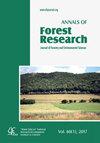Genetic diversity in European beech (Fagus sylvatica L.) seed stands in the Romanian Carpathians
IF 2.9
3区 农林科学
Q2 FORESTRY
引用次数: 3
Abstract
In Romania, European beech (Fagus sylvatica L.) is the most important broadleaved tree species. The goal of the present study was to determine the genetic diversity and differentiation in and between natural beech populations from the Romanian Carpathians and the transmission of the genetic diversity to the next generation. The populations analyzed were registered as seed stands. Genetic analysis was based on ten nuclear microsatellites. The highest amount of genetic variation was within populations, whereas genetic differentiation between populations was low. In the adult populations the mean number of alleles per locus varied from 8.0 to 10.9, the effective number from 8.3 to 9.6. Heterozygosity ranged from 0.637 to 0.750 with the mean of 0.681(±0.018). The overall genetic differentiation FST between populations averaged 0.014. Geographic patterns within this region were not detected. Regenerating these stands naturally has not implied a reduction in the genetic variation in the following generation. Allelic richness, genetic diversity and heterozygosity in adult stands and their natural regeneration is not significantly different. Inbreeding effects were not observed (F between -0.032 and 0.061). The results complete the knowledge on genetic variation of beech in Romania and give insides into the genetic diversity of beech seed stands. They can be helpful too for the delineation of provenance regions in the Romanian Carpathians.罗马尼亚喀尔巴阡山脉欧洲山毛榉(Fagus sylvatica L.)种子林的遗传多样性
欧洲山毛榉(Fagus sylvatica L.)是罗马尼亚最重要的阔叶树种。本研究的目的是确定罗马尼亚喀尔巴阡山脉天然山毛榉种群的遗传多样性和分化,以及遗传多样性向下一代的传递。所分析的种群被登记为种子林。基因分析基于10颗核微卫星。居群内遗传变异最大,居群间遗传分化较小。在成年群体中,每个位点的平均等位基因数为8.0 ~ 10.9,有效等位基因数为8.3 ~ 9.6。杂合度范围为0.637 ~ 0.750,平均值为0.681(±0.018)。群体间总体遗传分化FST平均为0.014。没有检测到该区域内的地理模式。自然再生这些林分并不意味着下一代遗传变异的减少。成林及其自然再生的等位基因丰富度、遗传多样性和杂合度无显著差异。无近交效应(F在-0.032 ~ 0.061之间)。研究结果完善了罗马尼亚山毛榉遗传变异的知识,并深入了解了山毛榉种林的遗传多样性。它们也可以帮助划定罗马尼亚喀尔巴阡山脉的种源区域。
本文章由计算机程序翻译,如有差异,请以英文原文为准。
求助全文
约1分钟内获得全文
求助全文
来源期刊

Annals of Forest Research
FORESTRY-
CiteScore
2.20
自引率
11.10%
发文量
11
审稿时长
12 weeks
期刊介绍:
Annals of Forest Research is a semestrial open access journal, which publishes research articles, research notes and critical review papers, exclusively in English, on topics dealing with forestry and environmental sciences. The journal promotes high scientific level articles, by following international editorial conventions and by applying a peer-review selection process.
 求助内容:
求助内容: 应助结果提醒方式:
应助结果提醒方式:


